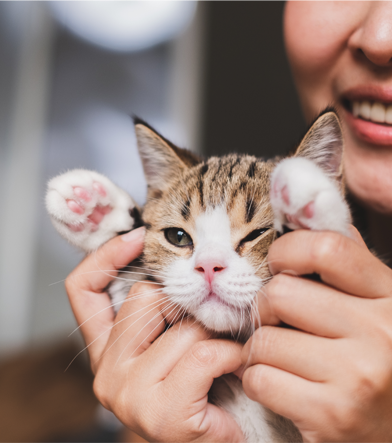Bulldogs and Their Delusional Speed: The Sprint That Never Was If you’ve ever watched a bulldog play, you’ve probably noticed something utterly hilarious. they...
The Essential Guide to Cat Vaccinations: What Every Cat Owner Needs to Know
The Essential Guide to Cat Vaccinations: What Every Cat Owner Needs to Know
Hi there! I’m Samantha, and if you’re like me, you want to make sure your cat lives a long, healthy, and happy life. Part of being a responsible cat parent is keeping up with vaccinations. Vaccines are an essential part of your cat’s wellness routine, protecting them from serious diseases and even helping to keep other cats safe by reducing the spread of contagious illnesses. Let’s dive into what you need to know about cat vaccinations, including the basics, the importance of each vaccine, and specific guidelines for my fellow California residents in Los Angeles and Orange County.
Why Cat Vaccinations Are Important
Vaccinations are critical for both indoor and outdoor cats. While you may think your indoor cat is safe from diseases, certain infections can be brought inside by humans, other animals, or even just through an open window. Core vaccinations protect your cat from highly contagious and sometimes fatal diseases, while non-core vaccinations can be essential depending on your cat’s lifestyle and the risk of exposure in your area.
Vaccines work by introducing a safe version of a virus or bacteria, which stimulates your cat’s immune system to create antibodies. If your cat is later exposed to the actual virus, their body will be equipped to fight it off more effectively. This preventive approach is essential in keeping your furry friend healthy.
Core vs. Non-Core Vaccines
Veterinarians classify vaccines into two main types: core and non-core. Core vaccines are recommended for all cats, while non-core vaccines are based on your cat’s specific lifestyle, age, and location.
Core Vaccines:
- Rabies: Required by law in many areas, rabies is a fatal disease that can be transmitted to humans. Even indoor cats are at risk if they accidentally escape or if a rabid animal (like a bat) enters your home.
- Feline Viral Rhinotracheitis (FVR): Caused by the feline herpesvirus, FVR affects the upper respiratory tract and is highly contagious.
- Feline Calicivirus (FCV): Another respiratory virus, FCV can cause oral and respiratory issues. It’s also contagious and can lead to severe infections.
- Feline Panleukopenia (FPV): Commonly known as feline distemper, FPV is a highly contagious and often fatal disease that attacks the immune system and gastrointestinal tract.
These core vaccines are typically combined into a single shot called the FVRCP vaccine, covering Feline Viral Rhinotracheitis, Calicivirus, and Panleukopenia.
Non-Core Vaccines:
- Feline Leukemia Virus (FeLV): Recommended for kittens and outdoor cats, FeLV is a serious disease that weakens the immune system. Indoor cats can be exposed if they interact with outdoor cats, making this vaccine worth considering even for some indoor-only cats.
- Bordetella Bronchiseptica: This vaccine is optional for cats in multi-cat households or boarding facilities, as Bordetella can spread rapidly in these environments.
Vaccination Schedule
A typical vaccination schedule starts when your kitten is around 6 to 8 weeks old, with booster shots every few weeks until they’re around 16 weeks old. Here’s a general outline:
- 6–8 Weeks: First FVRCP shot (Feline Viral Rhinotracheitis, Calicivirus, Panleukopenia)
- 10–12 Weeks: Second FVRCP shot, FeLV if recommended
- 14–16 Weeks: Final FVRCP and FeLV shots, rabies vaccination
After the initial kitten vaccinations, adult cats require boosters. Most core vaccines are given every 1–3 years, depending on the vaccine type and your vet’s recommendations. Rabies boosters are generally required every year or every three years, depending on the state and local regulations.
Cat Vaccination Guidelines by Location: Why It Matters
Vaccination requirements vary by state, city, and even by county. These laws are designed to protect not only pets but also public health. Understanding your local laws is important to ensure you’re compliant, especially with vaccinations like rabies, which is often legally required.
In California, vaccination requirements can vary between counties. Let’s take a closer look at guidelines for Los Angeles and Orange County.
Vaccination Guidelines in Los Angeles, California
Los Angeles County requires that all cats over the age of three months receive a rabies vaccination, even though the disease is not as common among cats as it is in dogs. Los Angeles also requires that rabies vaccinations be kept up-to-date, with booster shots administered either annually or every three years, depending on the vaccine type. While not every state mandates rabies vaccinations for cats, Los Angeles County has recognized the importance of this vaccine in preventing the spread of rabies from animals to humans.
Los Angeles also encourages pet owners to vaccinate their cats against other common feline diseases, particularly if they are outdoor cats or interact with other animals. Some local shelters and clinics offer low-cost or even free vaccination clinics, so check with your veterinarian or local shelter if cost is a concern.
Vaccination Guidelines in Orange County, California
In Orange County, rabies vaccination for cats is also recommended, though not mandated by law as it is for dogs. Many veterinarians in Orange County still advise cat owners to keep their rabies vaccinations up-to-date, especially if their cat spends time outdoors. Orange County also suggests core vaccines like FVRCP and, for high-risk cats, FeLV.
In both Los Angeles and Orange County, veterinarians often follow AAHA (American Animal Hospital Association) and AAFP (American Association of Feline Practitioners) guidelines for core and non-core vaccines. Rabies clinics are held periodically throughout both counties, offering affordable vaccination services for cat owners who want to ensure their pet is protected.
What to Expect After a Vaccination
Most cats tolerate vaccinations well, but some may experience mild side effects like soreness at the injection site, mild fever, or decreased appetite. These side effects are typically short-lived and should resolve within a day or two. However, it’s essential to monitor your cat after any vaccination. If you notice signs of an allergic reaction, such as swelling, vomiting, or difficulty breathing, contact your vet immediately.
The Bottom Line: Staying Compliant and Keeping Your Cat Healthy
Staying on top of your cat’s vaccinations is one of the most effective ways to protect them from serious illnesses. Vaccinations not only shield your cat from potentially fatal diseases but also play a crucial role in public health by preventing the spread of zoonotic diseases like rabies.
For Los Angeles and Orange County residents, following local guidelines is important. Even if not legally required in your area, vaccinations like rabies are still highly recommended for indoor cats, as they offer a layer of safety should your cat ever escape or encounter a wild animal.
Final Thoughts
Vaccinating your cat might seem like a small part of their care routine, but it’s one of the biggest ways you can ensure they live a long, healthy life. Scheduling regular vet visits and staying up-to-date with core and non-core vaccinations tailored to your cat’s lifestyle is a huge part of being a responsible pet owner. Cats bring us so much joy, and keeping them safe and healthy is the least we can do in return!
Whether you’re in Los Angeles, Orange County, or anywhere else, remember that your vet is your best resource for guidance. And when life gets busy, or you’re looking for someone to give your cat the love and attention they deserve, I’m here to help with pet-sitting, check-ins, and more. Let’s keep those whiskers twitching and those purrs strong! 🐾

Related Posts
husky care on the 19th Floor: Taking Care of Primrose, the Husky There’s something special about taking care of a dog that isn’t yours....





